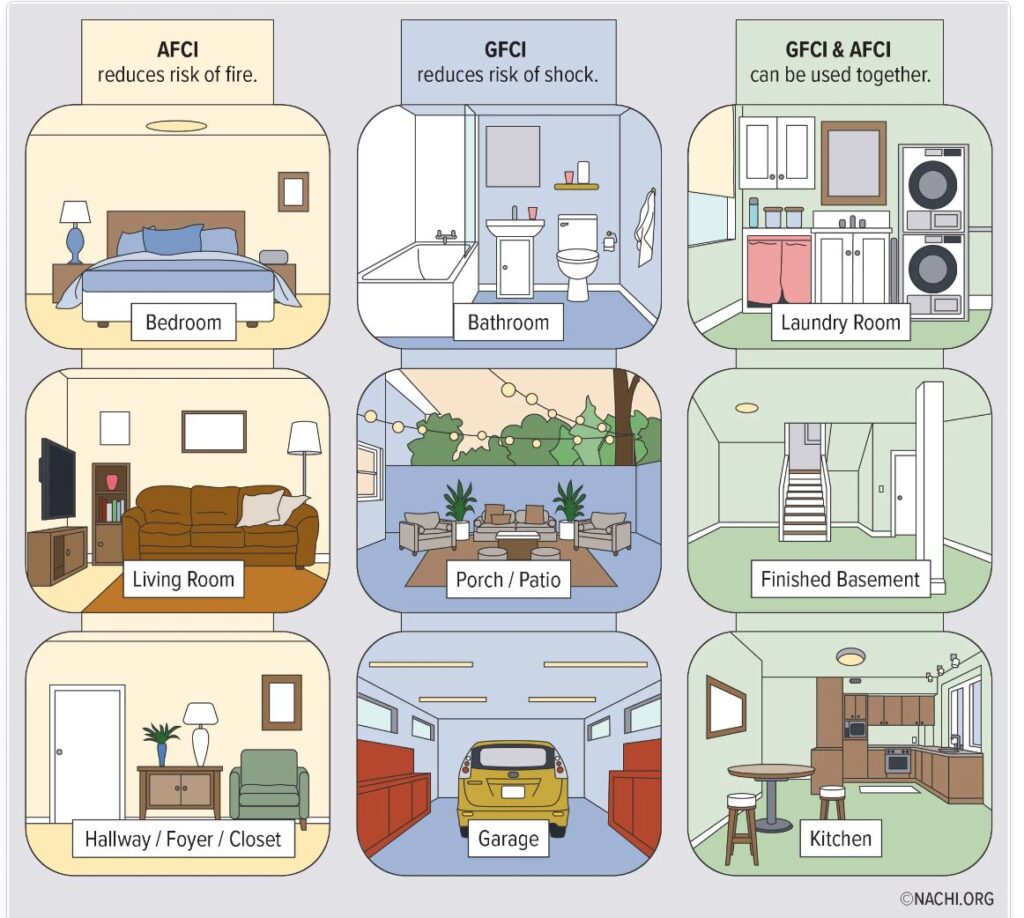Summary
- Electrical code is constantly changing and even new homes lack the very latest electrical safety components and practices
- You are not required to upgrade the home to meet new requirements unless you’re modifying the home (e.g. additions or remodeling) or replacing a receptacle.
- Updating parts of the electrical system can improve safety and possibly reduce your homeowner’s insurance premium
The National Electrical Code (NEC) spells out how a home’s electrical system must be constructed, and it’s this code that electrical inspectors inspect “to”. The NEC is revised every three years, but local jurisdictions are free to choose which code cycle to enforce and whether to amend or selectively enforce the code. Your home was constructed using the NEC standards in place at that time, but newer practices exist that improve upon electrical safety. This article briefly discusses some of those and is based upon the 2023 revision of the NEC.
GFCI
Ground Fault Circuit Interruption (GFCI) devices protect against electrocution and were first required in 1971 and interrupt the flow of electricity if they sense an imbalance in the current flow in and out of the device (indicating that someone could be getting shocked). These are available in the familiar push-button receptacle format as well as circuit breakers. GFCI protection can even be built into certain devices and systems, such as radiant floor heating controllers.
GFCIs were originally required in just outdoor areas but the list of required locations has slowly expanded over the years to include pretty much everywhere in a home. The latest list includes all receptacles in:
- Kitchens and Bathrooms
- Garages and Work Areas
- Outdoors
- Crawlspaces and Basements, and crawlspace lighting circuits (outlets).
- Areas with sinks and permanent provisions for food or beverage prep
- Within 6ft of a sink, bathtub, or shower stall
- Laundries
- Indoor damp and wet locations
- Sump pumps
- Dishwashers
- Electric ranges
- Wall-mounted ovens
- Counter-mounted cooking units
- Clothes dryers
- Microwave ovens
Integra Inspection Services home inspections only reports GFCI protection that’s missing from “legacy” locations that are historically and particularly prone to electrocution, such as the exterior, bathrooms, and wet locations. Although you are not required to add GFCI protection to areas not required at the time of the home’s construction (unless remodeling or adding/replacing receptacles), adding protection to all of the above areas increases your safety against electrocution.
- Family and living rooms
- Dining rooms
- Bedrooms
- Sunrooms
- Libraries and dens
- Office hallways
- Closets
- Recreation rooms
- Kitchens
AFCI protection is typically provided at the breaker panel through the use of AFCI breakers. Although you are not required to add AFCI protection to areas not required at the time of the home’s construction (unless remodeling or adding/replacing receptacles), adding protection increases your safety against electrical fire and may reduce your homeowner’s insurance premium. An electrician can typically replace the required breakers with AFCI types. However, older electrical panel boards may not support the use of new AFCI breakers and a panelboard replacement might be necessary.
Also known as combination AFCI/GFCI breakers, these are required to protect kitchens, dishwashers, clothes washers, and laundry areas. These protect against both electrocution and fire.
Tamper-Resistant Receptacles
Tamper Resistant (TR) receptacles help protect children from electrical shock by preventing them from sticking things in the receptacle holes. All receptacles in the home, garage, and outbuildings must now be tamper resistant. A TRR is a type of electrical outlet that requires double-prong entry in order for a plug to enter. These devices were designed to prevent the accidental insertion of hairpins, keys, knives, paper clips, nails, screws, and other small objects, which can pose an electrical shock hazard. Home inspectors and homeowners can identify these outlets by looking for the letters “TR” or the words “tamper-resistant” imprinted on the receptacle’s surface, which means that they’re tamper-resistant and have been tested to sustain periods of extended use and some forms of physical damage. TRRs are required for all receptacles below 5 1/2 feet above the floor. Exceptions exist for receptacles within dedicated space for an appliance that, in normal use, isn’t easily moved from one place to another or is part of a luminaire or appliance.
Surge Protection
All dwelling unit services must be protected with surge protection. Surge protection protects the electrical system against overvoltage conditions, such as from a lightning strike. Surge protection helps reduce damage to electrical components and devices and subsequent damage to the structure from fire. You are not required to add surge protection unless you’re required to replace the electrical panel during the course of a home remodel. However, many people voluntarily chose to have surge protection added. It’s not particularly expensive and can pay for itself many times over in the event of lightning strike or other damage to the power grid.
Emergency Disconnect
A means of disconnecting electric from the home must be available in a readily-accessible location outside the home. As with the other items above, you are not required to implement this unless you’re required to replace major electrical components such as the service panel during the course of a home remodel.

